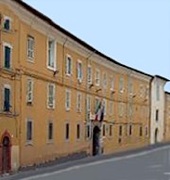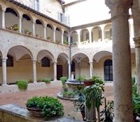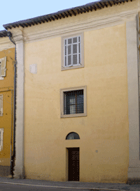


The Commune established a nunnery here in 1345 in houses belonging to Pelloso de Filippuccio. It was intended for women who repented of their worldly way of life, and was thus dedicated as "Sancta Maria Magdalenis de Repentutis". The commune was forced to intervene in 1351 because of the scandalous behaviour of the nuns.
The nuns followed an Augustinian rule until 1382, when their community was placed under the auspices of the Benedictine Monastero di Santa Caterina. In 1409, they received permission from the Commune to enlarge their church and nunnery.
In 1487, Pope Innocent VIII removed both Santa Caterina and Santa Maria Maddalena from episcopal supervision, at the request of the nuns, and placed them under the protection of the Cassinese monks of San Pietro.
In 1507, Pope Julius II confirmed the privileges of Santa Caterina and broke its association with Santa Maria Maddalena. Further restorations to the complex are recorded at around this time (in 1503 and again in 1509). The link with Santa Caterina was subsequently and intermittently restored until 1590, when it was definitively broken. The nuns’ association with San Pietro was terminated in 1703, when they returned to episcopal control.
The nuns acquired adjacent properties in Via del Grillo from the Conservatorio dei Derelitte in 1704. The complex was completely restructured in the course of the 18th century.
The nunnery was closed in the period 1810-15, although some of the nuns were allowed to continue to live in part of the complex. It was closed again, this time definitively, in 1864, when its nuns moved to Santa Caterina. Their old complex now houses the Umbrian headquarters of the Carabiniari, and is closed to the public.
Surviving Structure

-
✴the chapter room;
-
✴the refectory; and
-
✴the ex-church.

Frescoes (1630)
These frescoes by Cesare Sermei in the ex-church [can be seen through the window in the cloister ?]. The scenes include:
-
✴the Assumption of the Virgin;
-
✴St Mary Magdalen in glory;
-
✴St Mary Magdalen contemplating a crucifix; and
-
✴St Maximian administering the sacrament to St Mary Magdalen.
Art from the Church
Christ in glory with saints (1608)
This altarpiece, which was signed by Matteuccio Salvucci and dated by inscription, was recorded on the high altar in 1784 and was subsequently moved to the Galleria Nazionale. Unfortunately, it has been lost. It depicted Christ in glory with four saints, who included SS Benedict and Scholastica.
Communion of St Mary Magdalene (1738)

Read more:
T. Clifford, “Sebastiano Conca’s Communion of Mary Magdalen”, Burlington Magazine 114 (1972) 142-6
Return to Nunneries of Perugia.
Return to Monuments of Perugia.
Return to Walk IV.

